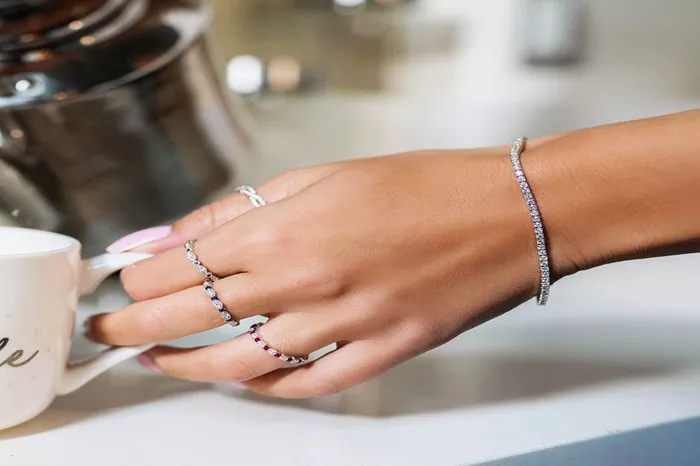Tennis bracelets are a popular choice for their elegance and simplicity, but they can be tricky to remove if you’re not familiar with the clasp mechanism. This guide will walk you through the different types of clasps commonly used in tennis bracelets, how to remove them safely, and tips on how to maintain your bracelet in top condition.
Understanding the Clasp Mechanism
Tennis bracelets come with various clasp designs, and knowing how to operate each one is essential for safely removing your bracelet without causing damage. The most common clasp types include:
Box Clasp: This clasp has a small button or hinge that locks into place and is often accompanied by a safety latch for added security.
Lobster Clasp: A spring-loaded clasp that features a small lever that opens to release the bracelet.
Slide Lock: A clasp with a small knob or lever that slides to unlock, allowing the bracelet to be taken off.
To identify your bracelet’s clasp, inspect the end of the bracelet where the links connect, and look for a small latch or button. Visual diagrams or images of each clasp type can help you confirm which one you have.
Step-by-Step Removal Instructions
Box Clasp
Locate the Clasp: Find the small hinge or button on the clasp. It’s usually located at the bracelet’s end.
Press the Hinge or Button: Gently press the small button or hinge to release the clasp. Some box clasps also feature a safety latch, which needs to be disengaged first.
Open the Bracelet: Once the clasp is released, gently pull the ends of the bracelet apart. Be careful not to force the clasp if it resists.
Lobster Clasp
Find the Lever: Locate the small lever on the clasp. This is typically located near the top of the clasp.
Press the Lever: Use your thumb to press the lever, which will open the clasp’s spring mechanism.
Release the Bracelet: Slide the clasp off the ring or loop on the other end to release the bracelet.
Slide Lock
Identify the Knob or Lever: Look for a small knob or lever on the side of the clasp, which is used to unlock it.
Unlock the Clasp: Push or pull the knob, depending on the design, to release the clasp’s lock mechanism.
Separate the Ends: Gently pull apart the bracelet at the clasp, ensuring you don’t apply too much pressure to avoid damaging the links.
Handling with Care
Tennis bracelets are delicate, and the links can be easily damaged if handled roughly. Here are some tips to ensure you don’t damage the bracelet during removal:
Use a Steady Grip: Ensure you have a firm, but gentle grip on the bracelet. Don’t pull or tug at the bracelet, as this could cause the clasp or links to bend.
Work on a Soft Surface: Remove your bracelet on a soft, flat surface like a towel or a jewelry mat. This will prevent the bracelet from slipping and reduce the risk of dropping or scratching it.
Be Patient: If the clasp feels stiff or difficult to open, don’t force it. Gently work with the clasp, and take your time.
Common Issues and Solutions
Sometimes, removing your tennis bracelet can be tricky, especially if the clasp doesn’t open easily. Here are some common issues and how to resolve them:
Stuck Clasp: If the clasp is stuck, try using a magnifying glass to get a closer look at the mechanism. You might be able to identify any dirt or debris preventing it from opening. Clean the clasp gently with a soft brush or cloth if needed.
Difficulty Finding the Release Mechanism: If you’re struggling to locate the release mechanism, try working in a well-lit area, and feel for the small lever or button. If you still can’t find it, refer to the manufacturer’s guide or seek professional help from a jeweler.
Clasp Won’t Open: If the clasp doesn’t open despite pressing or pulling the latch, don’t force it. Gently wiggle it or try using a soft tool (such as a wooden pick) to ease it open. If all else fails, consider having a jeweler inspect it.
Maintenance and Storage
To keep your tennis bracelet and clasp in good working order, follow these maintenance and storage tips:
Regular Cleaning: Clean your bracelet regularly to ensure that dirt and oils don’t accumulate around the clasp. Use a soft, damp cloth to wipe the clasp and links, and avoid harsh chemicals that could damage the metal or gemstones.
Proper Storage: Store your bracelet in a jewelry box with soft compartments or a fabric pouch to prevent it from tangling with other jewelry pieces. This also protects the clasp from being scratched or damaged by other pieces.
Inspection: Periodically check the clasp to ensure it’s functioning properly and there’s no wear and tear that could affect its ability to secure the bracelet.
Conclusion
Removing a tennis bracelet may seem intimidating at first, but by understanding the type of clasp and following these careful steps, you can easily and safely remove your bracelet without causing any damage. Whether you have a box clasp, lobster clasp, or slide lock, handling your bracelet with care and attention will ensure its longevity and keep it looking sparkling for years to come.
Related topics:

